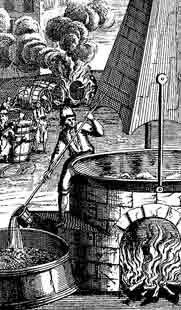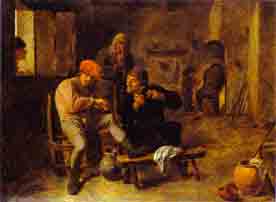Early Drinking.
ALE.
Beer has been brewed in Britain from as early as the first settlers. In 600AD a crude method of ale was brewed from grain and several other ingredients including heather, flowers and plants. It was a form of food and was usually made by the lady of the house in every house hold.
Archeologists have found pottery with traces of calcium oxalate (ale residue) which has been found at three sites in Scotland; Strathallan in Perthshire, Ashgrove in Fife and Machrie Moor in the Orkney Isles. The last two sites are Bronze Age, but the first is Neolithic with artefacts dating from c2600 BC. The ale traces found at Ashgrove and Machrie Moor in Scotland were found to contain immature lime pollen and traces of meadowsweet, suggesting that the ale had been flavoured to produce a primitive ale.
The public today uses the term "Beer" to describe all manner of alcoholic brews, but within the brewing industry, "beer" specifically means ale that has been flavoured with hops, which give the ale a distinctive bitter palate. Since hops were not introduced into Britain until the 15th century, some would say it is incorrect to use the term "beer" for any ale brewed before the 1400s whatever about the niceties, the inclusion of meadowsweet was a good choice, as the herb prolongs the shelf-life of ale by inhibiting fermentation.
 Brewing was practiced by Glasgow Clergy from the 12th century, even before Tennents brewery in Wellpark was even thought of, Glasgow Munks were brewing ale. The Molendinar Burn, was an ideal source of clean water for brewing.
Brewing was practiced by Glasgow Clergy from the 12th century, even before Tennents brewery in Wellpark was even thought of, Glasgow Munks were brewing ale. The Molendinar Burn, was an ideal source of clean water for brewing.
Black Friars (Dominicans) had brew houses on the High Street on the opposite side of the street from the Grey Friars (Franciscans) , their houses were on the west side of the street. These brew houses were well equipped for not only brewing ale but were used for baking bread. Part of Glasgow's daily intake consisted of bread drowned by ale. After the reformation the old brew houses were in a state of disrepair and became derelict.
Home brewing was a domestic chore, early Scotsman were always on the pull for a good wife especially if she could brew a good ale. Small commercial breweries were established in the Drygate, one of Glasgow's oldest streets. The Molendinar burn passed through the Drygate, Gallowgate before ending up in the River Clyde. Molendinar Street off the Gallowgate is a reminder that the burn passed here.
 Early Scottish ale had a sweet taste which was flavoured with herbs, plants, heather, including myrtle, ginger, gorse and broom, since hops were unknown at the time. Long after the Englishmen became used to ales made from hops, the Scots continued to sup sweet ale without hops.
Early Scottish ale had a sweet taste which was flavoured with herbs, plants, heather, including myrtle, ginger, gorse and broom, since hops were unknown at the time. Long after the Englishmen became used to ales made from hops, the Scots continued to sup sweet ale without hops.
The oldest known recipe for ale was found on a c1800 BC clay tablet found at the city of the in modern-day Iraq. The brewing method described is roughly as follows: "Bake cakes out of malted barley break up the cakes and mix with water and strain the resulting sweet-tasting liquor into large jars which should then be left aside to allow fermentation to take place."
In 1574 Glasgow Magistrates fixed the price of strong ale known as the "Kings Ale" at 6d a pint. The Magistrates employed twelve ale tasters to go into all the brew houses in the Glasgow. Tavern Keepers were allowed to sell ale in authorised containers such as a mutchkin. Scots pint was the equivalent of an English quart, while the Mutchkin held an English pint. At the end of the 16th century, hopped beer was first brewed in Glasgow and sold at a cost of 1 shilling 8d a pint. Beers brewed without hops was sold for a few pence cheaper.
In the 1600s Glaswegians were drinking German imported beer known as Mum Bier- spruce beer, along with the locally brewed ale. Drinkers in Glasgow were also getting drunk on French Claret, Spanish "Sack" (sherry and hot water) and aqua vitae (whisky.)
In the 1770s Glesga Punch- a mixture of Jamaican Rum, water, floavoured with citrus fruits as oranges, limes and lemons. Punch was the favourite tipple at all social functions, the punch was usually served in a large hand-painted china bowl.

PORTER
Porter was a tasty new brew that was devoloped in London in the 17th century because of market conditions involving taxation, economies of scale and a growing sophistication of taste among beer consumers. Porter's name is believed to be derived from the fact that porters working in London's markets particularly favoured it. At first it was known as "three thread," because it was originally made from a blend of three different ales- pale ale, mature dark ale and immature dark ale- that were kept in kegs behind a pubs bar counter. In 1722 a London brewer names Ralph Harwood produced a beer that could be supplied in a single barrel., yet which still had the complex aroma and taste of "three thread" porter beer. Using a mixture of three different qualities of ale which was known as three threads. Mr Harwood named his precious brew "Entire Butt" beer, it was later called Porter. The fact that the new brew was now supplied in a single keg also made it ideal for export.
Porter was dark coloured and discribed as having a sweet-bitter-taste and very potent. London Porter was consumed in large quantities by Galswegians.
In 1787, Arthur Guinness became the first brewer to produce porter, with other Irish brewers following suit, as a result, British beer imports started to decline.
The increased duties on Spirit imposed by the Gin Acts of 1744 and 1751 led to increased beer consumption within the licensed trade, but it also led to a boom in an unlicensed trade in whisky, described as "Poteen" from the 18th century onwards.
Wines and Claret
In the Burghs no doubt the people lived better than in the rural districts and in Glasgow, whatever their food may have been, they appear to have consumed a considerable amount of Wine. In early times it was only within Burgh that the sale of wine was permitted at all, and when a cargo arrived it was first proved by the "Tasters" and the price at which it was to be retailed in the Taverns was then fixed. In the same way each brewing of ale was proved by the official taster before it was permitted to be sold, and the price was regulated according to the price of malt, and "efter the Imoposicioune of the worthi man of the toun." Of wines, clarets was most in favour in Glasgow and indeed throughout Scotland. It was imported from Bordeaux by French and Scottish Traders. The other wines used were chiefly those of Guienne and Gascony. They were probably of a harsh and acid character compared with what are now imported, and the small quantity of sugar then consumed, most of which was imported from Italy, Sicily and Cyprus, was chiefly used to mix with the wine.
Browsters
The beer in Scotland during the greater part of the 15th century was mostly imported from Germany. When ale began to be manufactured in Glasgow, which it came to be a large extent, it was made both from oats and barley or bere, and in the absence of hops it was flavoured with ginger and other spices and aromatic herbs to fit it for keeping.
Women called "Browsters Wives," were then the only brewers and for a long time the taverns were almost exclusively kept by them. In the Burgh accounts of Glasgow there are repeated entries of payements for "Aqua Vitae" at the Corpooration dinners. This is not always to be confounded with brandy, to which, in earlier times as well as at a later period, the term was applied, It was often applied to whisky made from malt.
In 1494 the Exchequer rolls contaian an entry of the delivery of 8 bolls of malt to Friar John Cor to make aqua vitae. The quantity manufactured was however very limited. Till the 16th century the scale of distilling spirits was chiefly confined to the shop of the apothecary. It was used only as a luxury or medicinally.
Down to the time of the union claret was the wine principally drunk in Glasgow. An English traveller in 1660 said the people of Glasgow excel in good quality French wine. From a tavern bill in 1697 which had been preserved, we learn that claret was then charged at 20d (Stirling) the quart. Morer, writing in 1702 says the Scots, "have a thin bodied claret at ten pence the Mutchkin." After the union the price was higher. In 1729 Burt states, claret was charged at 1shilling 4d the bottle, and it was soon raised to 2 shillings. He says he found French claret "a wholesome and agreeable drink, in every public house of any note except in the heart of the Highlands and sometimes even there. The Laird of Culloden kept a hogshead of claret on tap in his hall for all comers and at Arniston House the country residence of President Dundeee there were sixteen hogsheads of claret used every year.
Wyne
In 1573 the Town Council appear to have thought it sufficient to present, and the bishop perhaps thankfully received "one gallon of wyne," for the price of which a charge appears in the burgh accounts. But as a rule the magistrates after the Reformation, were kind to the archbishops and repeatedly made them presents. On one occasion there is a charge for silver work given to the ladie Elphinstoun the bischops daughter at her marriage. On another there is an entry of the sowme of twelfe hundred threettie six pounds (£103) payit for French wynes given be the toun to the archbishop of Glasgow and utheris this last yeir. And there are many similar entries.
In 1670 there is again a considerable sum of twa hogheids of French wyne, twa rubors, and one butt of sek, sent to Edinburgh to some persons. A few years later 1674 Donald McGilchrist has a warrent for 240 pounds Scots "debursit be him for French wyne given be the town to Sir John Harper at severall tymes for services done be him to the said burgh."
In 1686 the Council appoints the Provost Baillie and Dean of Guild to gratifie such of the tounes friends as they shall think fitt by selling them what wynes they think convenient on the tounes accoupt. In 1688 the treasurer is ordained topay to Baillie Bell the sum of £12 for one hogshead of sack and £14 for half one tun of French wyne and £7 16 shillings and 8d, more for 2 cask of Rasenis and 2 cask of figs, all furnished by him on the touns account whilk were given severall of their friends of last year.
Town Council
There can be no doubt that one reason of the city spending so much in wine was that the taverns, which originally were almost entirely in the hands of women, were, many of them, now kept by officials of the burgh, baiies, deacon-conveners, and others. This had given rise to some scandal, so much so that in the end of the seventeenth century the town council was obliged to take up the matter. In the minutes "Several abuses had been committed these several years past by electing and choiseing of magistrates and deacon-convenrs in the burgh who keped change and publict taverns, which occasioned much debaushire and drunkeness, and poor people to spend their money needlesslie in said taverns. It is there hereby enacted statute and ordained in all tyme comings that nae person or persons be elected and choisen to bear office as Proveist, Baillies, Dean of Guild, Deacon-Convener, Baillie of Gorballs or as Water Baillie, wha Keipis and publict tavern or change house.
Glasgow's National Drink
Claret was Glasgow's national drink, it was many years before whisky was cheap enough to become the National Drink of Scotland. Claret was shipped from Bordeaux, France to Scotland in Hogsheads and consumed by Glaswegians in vast quantities. Claret at this time was duty free, however a tax was introduced during war times between France and Britain and the popularity of this favourite drink faided drasticly.
Whisky
In the 1700s Scotch Whisky was not what it is today, it lacked flavour, colour and smell and was discribed as a fierce pungent firewater, ale was not much better either.
End.
